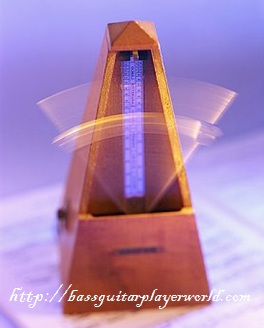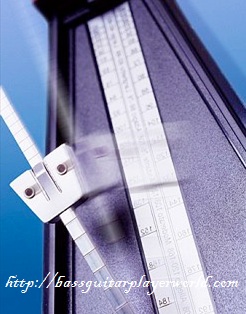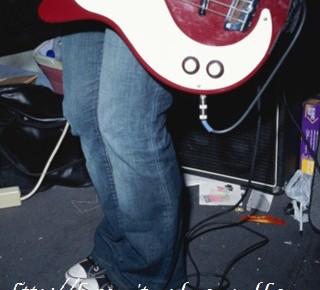Practicing With a Metronome For Best Results
 No matter what kind of musical groups we are talking of, it is the task of the drummer to keep everyone and the piece played in time. That is, unless it is intentional, the tempo of the music should not fluctuate.
No matter what kind of musical groups we are talking of, it is the task of the drummer to keep everyone and the piece played in time. That is, unless it is intentional, the tempo of the music should not fluctuate.
The ability to keep time is not something that everyone is born with; even the geniuses of bass playing need practice.
For that reason, every beginning bassist should own a metronome in order for his practice time not to be unprofessional.
The Benefits of Using One
It is often hard to tell if a piece of music is “off time” or not. By keeping track of your activity with a metronome you will have objective information regarding the tempo you are playing in. Also, in the beginning different tempos might just look like random numbers to you. Can you tell what is the difference between “sixty beats per minute” and “a hundred beats per minute”?
Sure – you might say – the latter is faster. But is that it? Can you tell the tempo of a song by just hearing it? Buying a metronome and using it for a while will teach you what the different tempos actually mean.
By learning these values you will have the opportunity to tell your band mates something like this to your drummer: “Hey, I have an idea, start playing a funky bass line at, like, 70 BPM, let us see how this turns out!”
When Should You Use the Metronome to Count?
In my experience the best idea is to only use your metronome during your practice sessions. However, if you paid attention to drummers during live shows, you might have noticed that many of them are using earphones.
These earphones usually have one of the following two functions: either they are monitors so that the drummer hears himself and the rest of the band or they actually are metronomes playing right in the ears of the drummer.
Using a metronome during a live show is risky business. Minor mistakes always happen, and if you or another member of the band goes off time and the metronome is still ticking in your ears chances are that you will mix up two different tempos eventually ruining the song.
By using a metronome during practice sessions and band rehearsals, you and your band mates ought to develop the ability to fix unexpected tempo problems on the fly. However, if the metronome is still ticking there in a live situation, this wonderful tool might even turn out to be dangerous.
How to Start Practicing With It?
 If you have been playing the bass for a while now without using the metronome you probably are pretty confident that keeping time is no real problem for you. Well, setting your metronome to a friendly value of sixty to eighty beats per minute and trying to play a simple rock beat will probably teach you some humbleness.
If you have been playing the bass for a while now without using the metronome you probably are pretty confident that keeping time is no real problem for you. Well, setting your metronome to a friendly value of sixty to eighty beats per minute and trying to play a simple rock beat will probably teach you some humbleness.
After that, you should probably spend a few hours with a simple combination of a bass amplifier and your shiny new metronome. Start practicing accentuation exercises, rudiments, and different playing your bass to different rhythmic patterns. The metronome tool and your bass amp are almost enough for building a surprisingly stable foundation for your bass playing career.
The metronome is a must-have tool for every bassist. However, you should not forget that you are not using a metronome to make your music sound robotically perfect – glitches always happen and you have to accept them. The metronome should only teach you to be able to command your instrument so that what you will be playing is actually what you wanted to play.
Check Out The Best Way to Learn Bass Online
If you want to go from being an average bassist to achieving a level of bass playing like a professional, JamPlay is the best resource to help you accomplish that goal in the shortest possible time. Learn from bass legends like Billy Sheehan, David Ellefson and Bryan Beller with an ever-growing library of video lessons designed to help you improve your skills.
Related Articles
Comments are closed.





